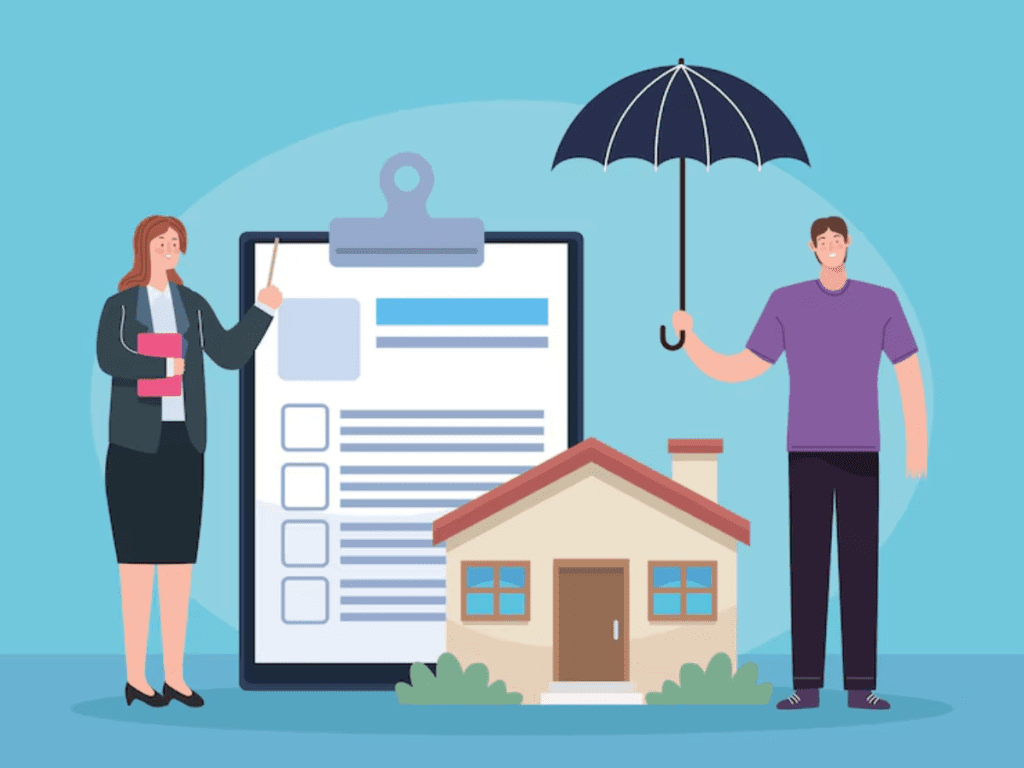Introduction
Securing your home is not as easy as choosing the policy and then paying the premiums. The process of insuring your home is much more than that. Homeowners insurance is a valuable resource for protecting your home from financial damage due to a range of unexpected occurrences, and knowing how to select the ideal policy involves weighing a number of important factors carefully. Where your home is situated, the type of natural disasters that can happen to it, and the overall worth of your home are all important elements that will decide the kind of insurance protection you should have. Here in this article, we are going to examine in detail how to insure your house properly considering these factors, so that you receive the cover you require for your specific scenario.
The Importance of Location in Homeowners Insurance
Location plays a significant role in determining your homeowners insurance coverage. Your home’s geographical location can influence not only the risks your home faces but also the cost of your insurance premiums. Insurance companies use location-based data to assess the risk of insuring a property, and they adjust policies accordingly. Therefore, when purchasing homeowners insurance, it’s essential to take your location into account and understand the risks that come with it.
Urban and Rural Differences
Where you live, either in a rural or urban setting, can significantly influence what kind of coverage you require. Urban settings tend to have their own list of problems, like a greater possibility of theft, vandalism, and accidents because of the high population density and traffic. The increased threat in these places can translate into higher premiums. Moreover, urban regions can have higher repair prices since labor and materials tend to be more costly, particularly in densely populated cities where demand is greater. Conversely, rural regions could have other problems. Although the risk of theft or vandalism is perhaps lower, rural residences could have additional challenges in the case of a disaster since they tend to be located farther from emergency personnel, and there is a slower response time if help is needed. This reduced reaction time can amplify the extent of natural disaster damage, so it’s important to make sure that your insurance policy takes into consideration these particular factors.
Coastal Areas and Risks of Flooding
Residing in coastal areas can provide lovely scenery and a wonderful climate, but it has its own big threats, particularly from flooding, hurricanes, and storm surges. Houses in coastal areas are most at risk for such natural calamities. Standard homeowner insurance does not cover damages from floods, and therefore, it’s extremely important for residents in flood areas to buy separate flood insurance. Flood insurance, which is generally provided by the National Flood Insurance Program (NFIP) or private insurance companies, safeguards your home against the catastrophic impacts of floods. Additionally, homes near the coast may face a heightened risk of wind damage, particularly from hurricanes. Many coastal areas experience frequent hurricane activity, and it’s often necessary to include windstorm coverage in your insurance policy to protect against wind damage. This coverage may come as a separate rider or deductible depending on the insurance company and the region.
High-Crime Areas and Theft Coverage
If you reside in a region with above-average crime rates, your homeowners insurance policy will probably need to cover more extensive protection against burglary, theft, and vandalism. High-crime areas tend to experience more frequent claims, which might raise your premiums. In addition to the standard coverage for theft of personal property, some insurance providers offer specific riders for high-crime areas, which may include protection for your home’s exterior, valuable personal belongings, and even identity theft. Be sure to ask your insurance provider about the availability of such coverage options and how they could help protect your home in the event of criminal activity.
Natural Disasters and Their Impact on Homeowners Insurance
Natural disasters are random and frequently catastrophic, yet can also play an important role in determining what to insure your house for. The likelihood of natural disasters is highly dependent on where you live, and this can affect the type of coverage that you require. It’s worth knowing the particular risks that exist in your area and selecting a policy that will give you proper protection in the case of a disaster.
Flooding and the Requirement for Specialized Insurance
Flooding is the most prevalent and destructive of natural disasters, yet standard homeowners policies rarely include flood damage. If you reside in a region known to experience flooding, you will need to have special flood insurance to safeguard your home. Floods can occur due to a variety of reasons, including heavy rain, rising rivers, or even coastal storm surges. Many homeowners mistakenly believe that flood insurance is only necessary for those living near rivers or oceans, but even homes located far inland can be affected by flooding. Flash floods, for example, can happen suddenly and with little warning, making it vital to secure flood coverage regardless of your location. Flood insurance covers the expense of restoring the building of your house, and also damage to personal belongings, and can even cover temporary living costs should you have to leave your house following a flood.
Hurricanes and Windstorm Insurance
Aside from floods, hurricanes and windstorms can wreak havoc on houses, especially in coastal areas. Most basic homeowners policies do offer some coverage for wind damage, but this does not always hold in areas known for hurricane frequency. For areas that do see frequent hurricanes, some insurance companies do sell hurricane or windstorm policies as an additional rider. These policies can assist with coverage for damage from high winds, falling trees, and airborne debris. If you reside in a region prone to hurricanes, you might also have to pay an additional hurricane deductible, which is usually used for wind damage claims. It is essential to check your insurance policy to see if it has the right coverage for wind and hurricane damage, as these incidents tend to destroy a lot of property.
Wildfires and Fire Protection
Wildfires are a mounting issue in arid climates, especially in the US West. In wildfire-prone communities, fire damage is often covered in homeowners policies. That said, policies can differ by insurer and location, and a homeowner might need extra coverage for a house in a high-risk wildfire area. Insurance providers can also provide discounts or incentives to homeowners who take active measures to safeguard their property from wildfires, like establishing defensible space around the house or employing fire-resistant materials for roofing and siding. Homeowners in high-risk wildfire areas should ask about fire protection coverage options and be willing to pay more for premiums because of the higher risk.
Earthquake Insurance and Seismic Activity
Earthquakes are yet another type of natural disaster that homeowners must take into account when choosing insurance coverage. In regions where there is high seismic activity, like California or Alaska, earthquake insurance is a necessary factor to consider. Unfortunately, most standard homeowners insurance policies do not cover earthquake damage. If you reside in a seismically active region, it is worth investing in a standalone earthquake insurance policy to safeguard your home against structural damage and loss of personal belongings. Earthquake insurance can assist with the cost of repairing or rebuilding your home, replacing personal items, and even temporary housing if your home becomes unsafe to live in. Similar to flood insurance, earthquake coverage is usually provided by private insurers or through specialized programs.
Assessing the Value of Your Home for Insurance
Your home’s value is yet another important consideration when it comes to determining what type of insurance coverage you will require. When you insure your home, you want to make sure you are covered for the entire replacement value of your property in case it gets damaged or destroyed. Valuing your home correctly will ensure that you don’t end up underinsured or paying extra for unnecessary protection.
Replacement Cost vs. Market Value
One of the most important concepts to grasp in calculating your home’s worth for insurance coverage is the distinction between replacement cost and market value. The replacement cost is the price it would cost to replace your home today at prevailing construction costs, whereas market value is how much your home would sell for in today’s real estate environment. Homeowners insurance usually pays for the replacement value of your home, not the market value. The market value varies depending on a number of factors like location, demand, and condition of the property, while the replacement value is more constant and represents the cost of materials and labor to reconstruct your house. It’s essential to ensure that your insurance policy covers the full replacement cost to avoid being underinsured in the event of a total loss.
Home Renovations and Property Value Fluctuations
The value of your home is not static—it can change over time due to renovations, improvements, and market conditions. If you undertake major improvements to your home, like installing a new roof, renovating your kitchen, or putting in energy-efficient windows, you should adjust your insurance coverage to match these improvements. Otherwise, you could end up underinsured, which would mean you wouldn’t get enough money to rebuild or repair your home after a disaster. Also, market conditions may influence the overall value of your home. If your local property values go up, it is worth reviewing your coverage to confirm that it meets the value of your home currently.
High-Value Houses and Custom Coverage
Homeowners who have luxury or high-value houses might not find basic homeowners insurance adequate. Such homes might feature specialized design elements like customized homes, luxurious materials, or priceless personal possessions that could be entitled to specialized coverage. For instance, if you have valuable artwork, jewelry, or collectibles, you might require a policy that has additional protection for such items. High-end homes also usually come with higher square footage and intricate structural components, which will be more expensive to repair and rebuild. In these situations, it’s best to hire an insurance company that deals with high-end homes to make sure that you get the right coverage for your home’s specific requirements.

